
About UsThe Numismatic Bibliomania Society is a non-profit organization promoting numismatic literature. For more information please see our web site at coinbooks.org SubscriptionsThose wishing to become new E-Sylum subscribers (or wishing to Unsubscribe) can go to the following web page link MembershipThere is a membership application available on the web site Membership Application To join, print the application and return it with your check to the address printed on the application. Membership is only $15 to addresses in the U.S., $20 for First Class mail, and $25 elsewhere. For those without web access, write to: David M. Sundman, Secretary/TreasurerNumismatic Bibliomania
Society AsylumFor Asylum mailing address changes and other membership questions, contact David at this email address: dsundman@LittletonCoin.com SubmissionsTo submit items for publication in The E-Sylum, just Reply to this message, or write to the Editor at this address: whomren@coinlibrary.com
BUY THE BOOK BEFORE THE COINYou won't regret it! |
- WAYNE'S WORDS: THE E-SYLUM AUGUST 17, 2008
- HARDBOUND PRESENTATION ASYLUM INDEX GIVEN TO COMPILER BILL MALKMUS
- NBS 2008 NUMISMATIC LITERATURE SYMPOSIUM REPORT
- LAKE BOOKS 94TH NUMISMATIC LITERATURE SALE CLOSES AUGUST 19, 2008
- NEW BOOK: COLLECTING CONFEDERATE PAPER MONEY - FIELD EDITION 2008
- NEW BOOK: THE JAMESTOWN EXPOSITION, 1907 BY IRA REED
- REVIEW: 100 GREATEST ANCIENT COINS BY HARLAN BERK
- REVIEW: HOLABIRD-KAGIN AMERICANAS 2008 AMERICAS GOLD RUSHES CATALOG
- REVIEWS: GOOD MONEY BY GEORGE SELGIN
- UNIQUE BRAILLE EDITION OF THE 1969 RED BOOK TO BE EXHIBITED IN ATLANTA
- NEW BOOK: BLUE MAURITIUS - THE HUNT FOR THE WORLD'S MOST VALUABLE STAMPS
- MORE ON THE BURNETT ANDERSON MEMORIAL AWARD FOR NUMISMATIC WRITING
- C. M. NIELSEN, PHILIPPINE GUERRILLA CURRENCY RESEARCHER
- MORE ON COIN FLIPPING LORE
- QUERY: WHY DID THE U.S. MINT PRODUCE SO MANY HALF CENT ERRORS IN 1825?
- QUERY: DO YOU HAVE A 'CHARTER OAK' GROWING NEARBY?
- PIONEER GOLD FORUM: OTHER SUSPECT PIECES UNDER THE LENS
- NUMISMATIC LITERATURE EXHIBITS AT THE 2008 BALTIMORE ANA CONVENTION
- WAYNE'S NUMISMATIC DIARY: AUGUST 12, 2008
- NEWSPAPER ARTICLE HIGHLIGHTS 1952 SCOVILLE SPINNER TOKEN
- FIRM TOUTS SOFTWARE USED BY U.S. MINT TO DESIGN COINS
- CARSON CITY CELEBRATES 150TH WITH MEDALS AND CUPCAKES
- PLAN TO MELT PRE-1982 U.S. CENTS FAILS TO SOLIDIFY
- COUNTERFEITS ON THE INTERNET: TIFFANY VS EBAY
- NEW TOOL TO PIGGYBACK ON MILLIONS OF WEB USERS TO DIGITIZE BOOKS
- PAY BILLS WITH YOUR CELL PHONE USING OBOLS
- TREASURE HUNT: A TWIST ON THE OLD COIN DROP PUBLICITY PLOY
- A "HOBO" HOMER SIMPSON ON A SPANISH EURO COIN
- FEATURED WEB PAGE: ANCIENT MONSTERS ON ANCIENT COINS
WAYNE'S WORDS: THE E-SYLUM AUGUST 17, 2008
 Among our recent subscribers are Leonard
Goldberg and Harvey Gamer, courtesy of Alan Weinberg, Rodrigo Eckholt,
Terry Sparks and Steve Middleton. Welcome aboard! We now have 1,176
subscribers.
Among our recent subscribers are Leonard
Goldberg and Harvey Gamer, courtesy of Alan Weinberg, Rodrigo Eckholt,
Terry Sparks and Steve Middleton. Welcome aboard! We now have 1,176
subscribers. This week we open with some NBS news, including a report on our Numismatic Literature Symposium at the recent Baltimore ANA convention. Several books are covered this week, including new books on Confederate paper money and the Jamestown Exposition. Reviewed this week are 100 Greatest Ancient Coins, Good Money and the America's Gold Rushes catalog.
Queries this week address 1825 error half cents and Connecticut's Charter Oak. In the news, an old Scovill-produced token is featured in a newspaper article, a firm touts its design software at the U.S. Mint, and Carson City celebrates its 150th anniversary by striking medals.
To learn who "A. Seaman" is, or which European coin features Homer Simpson, read on. Have a great week, everyone.
Wayne Homren
Numismatic Bibliomania Society
HARDBOUND PRESENTATION ASYLUM INDEX GIVEN TO COMPILER BILL MALKMUS
William Malkmus writes:
I am most appreciative of this gift and the thought behind it and extend my gratitude to all those concerned with its production.
NBS 2008 NUMISMATIC LITERATURE SYMPOSIUM REPORT
The Numismatic Bibliomania Society held its annual numismatic literature symposium at the recent 2008 American Numismatic Association convention in Baltimore. Here's a report. About 48 people attended, according to my notes - about two dozen around a large U-shaped table arrangement, and about the same number seated in rows of chairs behind. I don't have the signin sheet, but attendees included me, John W. Adams, David Alexander, David Davis, David Fanning, Dan Friedus, Dan Hamelberg, Dave Hirt, George Kolbe, David Lange, Syd Martin, Joel Orosz, P. Scott Rubin, Douglas Saville, David Sklow, Pete Smith, Jeff Starck, Barry Tayman, and Ray Williams.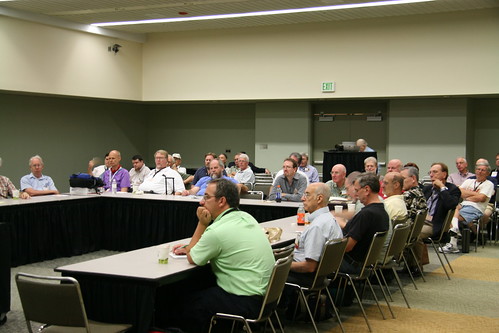
The topic was self-publishing numismatic books. The speakers were Syd Martin, author of The Hibernia Coinage of William Wood (1722-1724) and David Lange, author of Coin Collecting Boards of the 1930s and 1940s: A Complete History, Catalog & Value Guide `
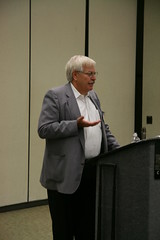 Syd started his talk with the story of how he
first became interested in collecting the Wood's Hibernia coinage. He came
across a red uncirculated 1723 example in a coin dealer's stock and bought
it, thinking it must be a great bargain. He learned from the Breen
Encyclopedia that 125 varieties were known. Syd began seeking out the
varieties, and accumulated over 250!
Syd started his talk with the story of how he
first became interested in collecting the Wood's Hibernia coinage. He came
across a red uncirculated 1723 example in a coin dealer's stock and bought
it, thinking it must be a great bargain. He learned from the Breen
Encyclopedia that 125 varieties were known. Syd began seeking out the
varieties, and accumulated over 250!He began cataloging his collection, separately enumerating and describing each obverse and reverse variety. He compiled a table listing all the known pairings of obverse and reverse dies.
He used MS-Word for his manuscript, with MS-Excel for tables and Adobe Photoshop for images. After putting it all together he created an Adobe .pdf file for the publisher. One problem was that the .pdf format did not properly retain the image rotation. To resolve this, he had to use a copy of Quark for the final page layout.
When the printer asked him how many signatures were in the book, Syd said he replied, "Oh, I dunno, maybe I'll sign a few of them..." He laughed at his ignorance, but only a few bibliophiles in the room got the joke. Books are printed and bound in groups of "signatures" - each signature consists of even number of pages, typically 16 or 32. Syd's book ended up being 512 pages.
Syd thanked the Colonial Coin Collector's Club (C4) for publishing his book. To encourage and assist authors in the field, C4 pays all publishing and printing costs and provides editors. C4 collects all proceeds until the production costs are covered, then splits the remaining profits with the author. 500 copies of Syd's book were produced in hardbound, with a dust jacket. 250 were sold in the first six months.
In the question and answer period George Kolbe said Syd's talk was "the best exposition I've ever heard about how to make a book."
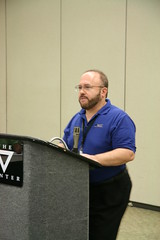 It was a tough act to follow, but David Lange
was up to the task. He first noted the similarities between his project
and Syd's - both involved cataloging a subject not well known &
understood in the hobby. Both projects had similar motivation, mechanics
and economics. David also agreed that he preferred working in MS-Word
rather than a page layout tool like Quark.
It was a tough act to follow, but David Lange
was up to the task. He first noted the similarities between his project
and Syd's - both involved cataloging a subject not well known &
understood in the hobby. Both projects had similar motivation, mechanics
and economics. David also agreed that he preferred working in MS-Word
rather than a page layout tool like Quark. David bought a large flatbed scanner for $250 to create the images of his Coin Boards, and hired designer Mary Jo Meade to create the book's visual theme and layout. Over 1,000 copies were printed and to date 440 have been sold, putting the project within $500 of the break-even point. To keep costs in line David chose a thinner paper than he would otherwise prefer, did without a hardbound edition and opted for a coil binding instead. Another cost-reducing measure was grouping the color images into the same signatures.
He spoke to Roger Burdette for advice on choosing a printer. After ruling out printers in his own area, David chose the printer who did Roger's Renaissance of American Coinage books, Signature Book Printing. One last-minute problem involved reproducing the color images. Dave went through three rounds of proofs at $24 a page before the print was able to accurately reproduce the color of the coin boards.
By the way, congratulations to David, who received the ANA's second place Wayte and Olga Raymond Memorial Award for his article on Joseph Post, which ran in the August 2007 issue of The Numismatist. In addition, the Numismatic Literary Guild (NLG) presented him with an Extraordinary Merit award for his book.
Many thanks to both speakers for their enlightening presentations on how to make a book. Hopefully their advice will be of use to future numismatic book authors.
LAKE BOOKS 94TH NUMISMATIC LITERATURE SALE CLOSES AUGUST 19, 2008
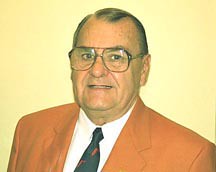 A reminder that our 94th mail-bid sale of
numismatic literature selected from the libraries of Col. Bill Murray and
John T. Hamilton III will close at 5:00 PM (EDT) on Tuesday, August 19,
2008. The sale may be viewed at: http://www.lakebooks.com/current.html
. Bids may be sent via email, fax, or telephone prior to the closing
time.
A reminder that our 94th mail-bid sale of
numismatic literature selected from the libraries of Col. Bill Murray and
John T. Hamilton III will close at 5:00 PM (EDT) on Tuesday, August 19,
2008. The sale may be viewed at: http://www.lakebooks.com/current.html
. Bids may be sent via email, fax, or telephone prior to the closing
time.Lake Books
6822 22nd Ave N.
St. Petersburg, FL 33710
(727) 343-8055 FAX:(727) 345-3750"
NEW BOOK: COLLECTING CONFEDERATE PAPER MONEY - FIELD EDITION 2008
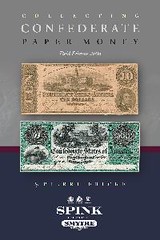 The new portable CSA paper money guide that
people have asked for is here! This is a full color, 456 pages, 6" x 9",
approximately 2.5 pound guide that is easy to use and carry around. Retail
price is $40.
The new portable CSA paper money guide that
people have asked for is here! This is a full color, 456 pages, 6" x 9",
approximately 2.5 pound guide that is easy to use and carry around. Retail
price is $40.I've received input from over 150 people and more than 30 people reviewed a draft of the book giving feedback on information presented and usability. One new element of this review phase was that we included people not directly involved in collecting or dealing in CSA paper money which added significant value in terms of usability.
There are several innovations present in this book, not found in any other paper money book. The regular issue and contemporary counterfeits are presented side-by-side, helping people tell the difference. There is a summary of both the type and variety condition census contained within, but in a format similar to what Dr. Sheldon used in his 1949 Early American Cents portable book to save space. We'll update the detailed condition census and provenance in a future 2nd volume.
A price guide for CSA bonds is included as there are no current plans for an update to Dr Ball's book, but new pricing information is needed. There is new information regarding the evolution of the hobby which has been quite dramatic this decade - more so than in any time in the past with the possible exceptions of the 1880s and 1950s. Some of this includes more about how to navigate the different styles of grading - including a table mapping equivalent grades across collector-oriented, market-oriented, CC&A, PCGS and other grading services.
Ralph Plumb, Collector:
It may be ordered here - www.csaquotes.com/csabooks.html The new CSA book will also be available from most numismatic book dealers, Spink Smythe and some paper money dealers (e.g., Richie Self). It also will be put on Amazon.com and may appear in other mass market channels.
NEW BOOK: THE JAMESTOWN EXPOSITION, 1907 BY IRA REED
 From the Amazon web site:
From the Amazon web site:
Hundreds of 1907 Jamestown Exposition items described, pictured in color and valued, with many additional useful tips and features for collectors and dealers, from a veteran collector/dealer in exposition memorabilia. Also includes listings for collectibles from the 1957 Jamestown Festival.
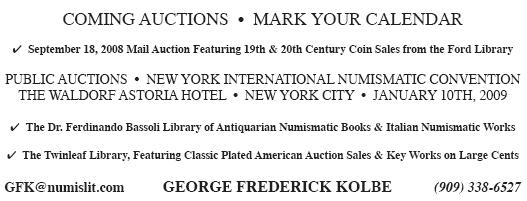
REVIEW: 100 GREATEST ANCIENT COINS BY HARLAN BERK
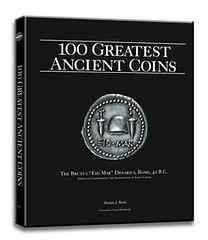 Just before the ANA convention I received my copy
of the latest in Whitman's "100 Greatest" series, "100 Greatest Ancient
Coins" by Harlan J. Berk.
Just before the ANA convention I received my copy
of the latest in Whitman's "100 Greatest" series, "100 Greatest Ancient
Coins" by Harlan J. Berk. From the publisher's web site:
If you've already peeked at the cover photo, you know the winner of the polling for the top ancient coin: the Brutus "Eid Mar" Denarius, Rome, 42 B.C., struck to commemorate the assassination of Julius Caesar. As with all "Top-Whatever" lists, there can be endless discussion and argument about the ordering and which items should or shouldn't be included. The author addressed this latter issue appropriately in the acknowledgements:
The book includes many coins that I was unfamiliar with, but that would be true of most of the BMC catalog, too. I'm not a collector of ancient coins (although every birthday my wife tells me I'm becoming an ancient collector). Yet I've always admired the beauty and history of ancients, and love looking at them. This is an ideal book for the lookers like me. The full color photographs are stunning. The accompanying text is long enough to cover a significant number of interesting facts about the each coin, but not so long that it gets tiresome.
Some of my personal favorites are:
- Arethusa facing head Tetradrachm by Kimon (No. 7)
- Athens Tetradrachm (No. 10)
- Kimon Decadrachm (No. 6)
- Cyzicus Electrum Staters (No. 75)
In a departure from the other books in the series, the ancient book is arranged chronologically rather than by rank. I agree with this decision - I think it makes the book easier to read, allowing one to follow the course of history and development of coin styles and technology. A table lists all 100 coins in their rank order. There is a seven-page appendix called a "Gallery of Coin Sizes". It illustrates at actual size each of the coin types included in the book, to give the reader a sense of their relative sizes.
For bibliophiles the Introduction discusses a number of standard references and the relative merits of books, auction catalogs, and Internet sites. The author concludes with an excellent observation:
For more information, see: 100 Greatest Ancient Coins (http://www.whitmanbooks.com/Default.aspx?
Page=81&ProductID=0794822622)
REVIEW: HOLABIRD-KAGIN AMERICANAS 2008 AMERICAS GOLD RUSHES CATALOG
It is arranged primarily by state with the state of California taking the largest part of the book, and with Nevada and Colorado having a sizable presence. Most other states that issued gold rush or related items are also represented. As you go from page to page you can see how much time-consuming research went into every item that is for sale in this FPL / Reference book.
Assay receipts make up a good portion of the catalog but you will also find many other paper items and ephemera included, such as bank notes, checks, drafts, photos, pamphlets and others. We have some assay receipts in our collection, along with western checks and drafts dealing with the gold rush. With these two books we will be able to update these collections with the very useful and interesting information contained within the pages of this great reference.
Many important pioneer gold coins, ingots and other metallic items are also included in the two books. Most items are pictured in full color with prices. What makes this such an outstanding fixed price list and reference is the well done descriptions of just about every item in the two printed catalogs. It is a walk down memory lane if you collect gold rush and related items that were issued both in metal and paper.
It is like a history book that covers from A to Z anything and everything you would want to know about the Gold Rush era in America. It is highly recommended for researchers, collectors, dealers, authors, bibliophiles, historians, librarians and others. We have many fixed price lists in our collection covering many areas of the hobby. We think this two volume set is possibly the most important Fixed Price List that has ever been issued.
The two volume reference was released at the ANA Baltimore Worlds Fair of Money Convention recently completed. Some of the items in the two catalogs were displayed at the convention and a photo of Don and Fred holding the catalogs in front of the display appears below. The two soft-bound printed books are available from Holabird-Kagin America at (775) 852-8822 for $50 shipped to US addresses. They also issued a very limited $25 quick-bind version of the catalog which isnt available.
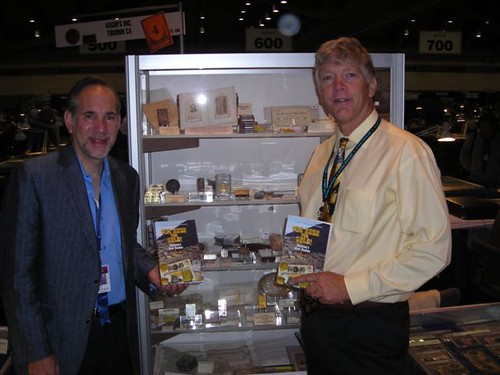
The firm is considering producing a special, limited Collectors Edition at $300 each. If you have any interest in this special edition, you should contact them quickly. For information regarding the catalog(s) or to purchase the printed version for $50, contact them at: Holabird-Kagin Americana, 3555 Airway Drive, Suite 308, Reno, NV 89511. You may also call (775) 852-8822, or email them at info@holabirdamericana.com or visit the firm's web page at http://www.holabird.org/
REVIEWS: GOOD MONEY BY GEORGE SELGIN
Larry Gaye writes: Im finally getting caught up from my travels of
a very busy summer. I picked up two copies of George Selgins book Good
Money from Scott & Lisa Loos at the ANA Convention and am in the
process of reading it. I can tell you it is not a boring tome on economics
but rather a ticket back in time to visit the period of the Industrial
Revolution. We take for granted the availability of a steady source of
currency to fuel our economy; some would say we have too much fuel.
Im finally getting caught up from my travels of
a very busy summer. I picked up two copies of George Selgins book Good
Money from Scott & Lisa Loos at the ANA Convention and am in the
process of reading it. I can tell you it is not a boring tome on economics
but rather a ticket back in time to visit the period of the Industrial
Revolution. We take for granted the availability of a steady source of
currency to fuel our economy; some would say we have too much fuel.
As a Conder Token dealer and collector this book really makes these lovely bits of copper come alive from their birth till now. In view of how many tokens were produced, we can thank the likes of Boulton, Watt, and Wilkinson to name a few for some of the best coins, oops, tokens ever produced.
I have not as yet completed the book which has already given a lot of itself. Thanks, George Selgin for your hard work in making it a lovely read.
Dick Doty writes:
UNIQUE BRAILLE EDITION OF THE 1969 RED BOOK TO BE EXHIBITED IN ATLANTA
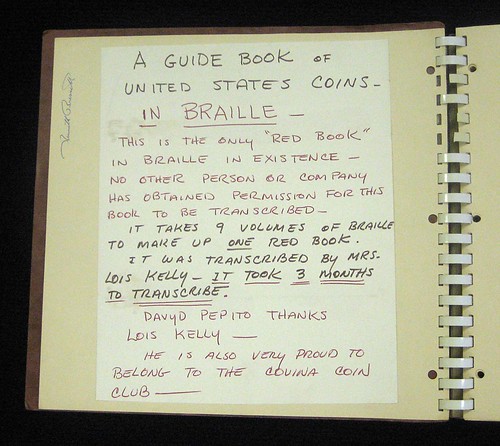
Gifts to the National Federation of the Blind will be accepted during the show, with stations set up at the exhibit. By donating to the National Federation of the Blind, you can help make a significant difference in the lives of blind people across the country. (The National Federation of the Blind is a 501(c)(3) organization, and your gift is tax deductible.) Anyone donating $10 or more at the show will receive a special limited-edition commemorative elongated coin (while supplies last), compliments of the Richard Mantia family.
The Whitman Coin and Collectibles Atlanta Expo will be held at the Cobb Galleria Centre in Northwest Atlanta, August 2123, from 10 a.m. until 6 p.m. daily. Parking and admission is free.
To read the complete article, see: Unique Braille Edition of the 1969 Red Book on Exhibit (http://www.whitmanexpo.com/contentPages/ShowArticle.aspx?ID=61)
To read the complete article, see: Rich Mantia's Redbook photos (http://www.flickr.com/photos/coinbooks/sets/72157604113900589/show/)
NEW BOOK: BLUE MAURITIUS - THE HUNT FOR THE WORLD'S MOST VALUABLE STAMPS
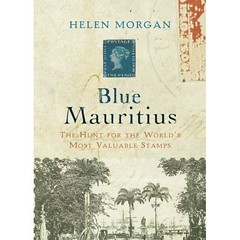 How tough can it be to be king? If we take the
example of Britain's George V, the answer may be: not very. During his
reign (1910-36), George was known to spend about four hours a day with his
stamp collection. On royal tours, his lackeys let receiving heads of state
know that if they wanted to present the monarch with a gift, George would
gladly forgo the usual engraved salver in favor of a rare philatelic
specimen from Antigua or the Cape of Good Hope. In February 1908, when he
was still the Duke of York, George wrote to a friend regarding the
purchase of some stamps from Barbados: "Remember, I wish to have
the best collection, and not one of the best collections in
Britain."
How tough can it be to be king? If we take the
example of Britain's George V, the answer may be: not very. During his
reign (1910-36), George was known to spend about four hours a day with his
stamp collection. On royal tours, his lackeys let receiving heads of state
know that if they wanted to present the monarch with a gift, George would
gladly forgo the usual engraved salver in favor of a rare philatelic
specimen from Antigua or the Cape of Good Hope. In February 1908, when he
was still the Duke of York, George wrote to a friend regarding the
purchase of some stamps from Barbados: "Remember, I wish to have
the best collection, and not one of the best collections in
Britain."By then he was already well on his way, having acquired in 1904 -- for the unheard-of sum of 1,450 -- an essential component of any great stamp collection: the two-pence "Post Office" Blue Mauritius. As Helen Morgan writes in her enticing history of the little square of paper and the people who have pursued it, the Blue Mauritius was issued in 1847 by the then British-ruled island nation in the southwest Indian Ocean. Ms. Morgan notes that the stamp, of which 13 are known to exist, is a thousand times rarer than the famed Penny Black, the world's first adhesive stamp, issued in Britain in 1840.
The tale begins with the glamorous ball held in Port Louis, Mauritius, in 1847 by Lady Gomm, the wife of the island's British governor, Sir William Gomm. Not content with the prospect of a big party, she wanted special stamps to put on the admission cards sent to her invited guests. Thus was born the one-penny orange-red and the two-pence blue, establishing Mauritius as only the fifth country in the world to issue postage stamps.
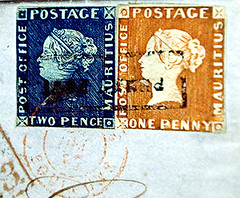 Ms. Morgan, an Australian, does not class herself
as a stamp collector, but she can proudly claim to be a philatelist --
that is, someone who cares a great deal about postal history. Her book,
which is as much travel memoir as detective story, was sparked by her
marriage to a Mauritian man and a trip to the island at the time of the
opening of a museum dedicated to the stamps.
Ms. Morgan, an Australian, does not class herself
as a stamp collector, but she can proudly claim to be a philatelist --
that is, someone who cares a great deal about postal history. Her book,
which is as much travel memoir as detective story, was sparked by her
marriage to a Mauritian man and a trip to the island at the time of the
opening of a museum dedicated to the stamps.She became enthralled by one story in particular, involving a French schoolboy who discovered, in 1902, one of the orange-red and two of the blue Mauritius stamps in the correspondence of a Bordeaux wine merchant. In 1993, one of the letters, bearing the orange-red and one of the blues side by side, was sold for $4 million, a philatelic record.
To read the complete article, see: Stamps of Wild Approval (http://online.wsj.com/article/SB121822908956325429.html)
MORE ON THE BURNETT ANDERSON MEMORIAL AWARD FOR NUMISMATIC WRITING
Larry Gaye writes:Here's another photo from the banquet, provided by John Wilson. That's John Eshbach of the Lancaster area with my wife Dee and I, and the famous $10 glass of wine. -Editor
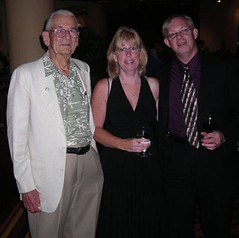
Larry adds:
THE BOOK BAZARRE
C. M. NIELSEN, PHILIPPINE GUERRILLA CURRENCY RESEARCHER
Neil Shafer writes:
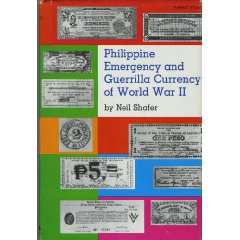 As a member of the merchant marine Niel was able to
visit the Philippines at least 30 times. During those visits he
accomplished some great research from first-hand sources on all aspects of
the complex issues of guerrilla currency during World War II. I had heard
of him before my 1974 book was to be published, and we had some
correspondence about several specific items before publication, but his
schedule did not allow for any substantive contact until much later, long
after the book came out. At first he was quite critical of the book, but
later on we became good friends and his criticism became a lot less
strident. I found his information to be without parallel in the field, and
I asked him to provide the data that has appeared for a while in the
Philippine section of the Standard Catalog Specialized Issues (Vol.
I).
As a member of the merchant marine Niel was able to
visit the Philippines at least 30 times. During those visits he
accomplished some great research from first-hand sources on all aspects of
the complex issues of guerrilla currency during World War II. I had heard
of him before my 1974 book was to be published, and we had some
correspondence about several specific items before publication, but his
schedule did not allow for any substantive contact until much later, long
after the book came out. At first he was quite critical of the book, but
later on we became good friends and his criticism became a lot less
strident. I found his information to be without parallel in the field, and
I asked him to provide the data that has appeared for a while in the
Philippine section of the Standard Catalog Specialized Issues (Vol.
I).He had much more information, especially on local issues, but since I was not actively working on the subject I did not pursue it with any degree of intensity.
I mentioned Ray Czahor earlier. He went to Salt Lake City this year and negotiated the purchase of Niel's entire holding of guerrilla currency, including all reference pieces and boxes of duplicates. I had the distinct pleasure of being able to see it all just after the ANA convention in Baltimore, and there are some really great and important pieces in this holding.
Ray and I went through it all, and we decided that in fact there was enough unpublished material at hand that we would like to try and update my 1974 publication if possible. It will be a long and slow process and we will keep you informed as to our progress from time to time.
Fred Schwan writes:
Unfortunately, CM was also secretive about most of the research. He intended to publish his results, but the years stretched to decades and now the fruit of most of his work is lost. It is great that Neil and Ray will be able to glean information from CMs collection.
Neil mentioned that CM was a merchant seaman. If you look in the early Toy books in the 1960s, you will see that A Seaman was a contributor. I did not learn for many years that A. Seaman was C. M. Nielsen.
MORE ON COIN FLIPPING LORE
Regarding the article How did flipping a coin become a decision-maker?, Mike Reynolds writes:Gar Travis writes:
QUERY: WHY DID THE U.S. MINT PRODUCE SO MANY HALF CENT ERRORS IN 1825?
Bill Eckberg writes:Does anyone know of a similar high proportion of errors for other series in 1825? Or, does anyone know of any mechanical or personnel issue(s) that might explain my findings? Please email responses to me at halfcent@mac.com. Thanks for any assistance you can provide.
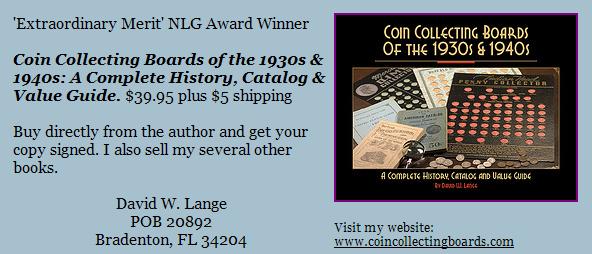
QUERY: DO YOU HAVE A 'CHARTER OAK' GROWING NEARBY?
While the branches of the tree nearly fill the flan of the quarter, The Charter Oak on the half is more realistic, with a massive trunk, gnarled branches in asymmetrical arrangement with more horizontal branches, and not nearly as tall as the one on the quarter. The half dollar was designed by sculptor Henry Kreis, who, in addition to the U.S. coin, was also commissioned to create the official 1935 Connecticut Tercentennial Medal.
A columnist in my local newspaper who specializes in the news of Connecticut's nearly 100 small towns, George Krimsky, wrote this week about the Charter Oak Tree. After recounting the story of how it got its name -- and the fact its acorns were sent across the globe to be planted elsewhere -- asked if any of the Charter Oak's progenies are still growing.
The history in a nutshell -- make that an acorn shell -- is that in 1662 King Charles II granted Connecticut a very liberal home-rule Charter. A quarter century tater, his successor, James II wanted to rescind that Charter and sent an envoy to retrieve it. They arrived in Hartford, found the Charter, and had it on the table of a tavern with a local delegation. Suddenly the candles when out, the room went dark. When relit the Charter had disappeared.
Story goes that Captain Joseph Wadsworth had spirited the scroll away and hid it in the cavity of a giant oak on a nearby estate. The British never got the Charter. The tree, now famous, was perhaps 400 years old at the time, and lived for another 170 years. A storm in the 1850s blew it down. People gathered to hold a funeral for the tree, and carried away shards of wood and its acorns. So many of these were planted until one historian stated these acorns "produced in time a forest of trees directly descended from the historic oak."
Fast forward to 1932: saplings from the second generation Charter Oak trees were again distributed. And this occurred again in 1962 on the 300th anniversary of that original Charter when then Governor John Dempsey called for saplings from "certified descendants" of the original Charter Oak. He ordered that saplings were sent to every state governor and President John F. Kennedy.
Thus the Charter Oak lives on. In its descendants, in its history and Connecticut heritage, and on American coinage.
Now what George Krimsky wants to know -- where are any of these descendant oak trees? Were any grown outside the state? His email address is: gkrimsky@rep-am.com His column can be accessed at Waterbury Republican American.
PIONEER GOLD FORUM: OTHER SUSPECT PIECES UNDER THE LENS
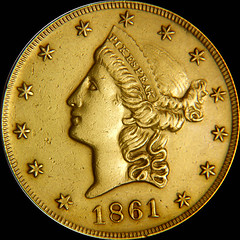
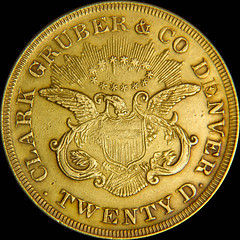
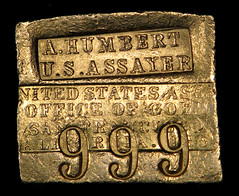
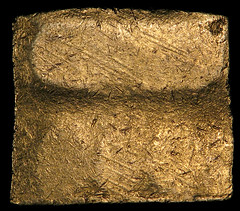
NUMISMATIC LITERATURE EXHIBITS AT THE 2008 BALTIMORE ANA CONVENTION
There were two exhibits in the Numismatic Literature class at the recent 2008 Baltimore convention of the American Numismatic Association. I spent some time looking at all of the exhibits together with Joel Orosz on Thursday, July 31. Here are their descriptions from the convention exhibit guide.Artistic Illustrations
The multi-case exhibit included several numismatic books, including
- Newcomb, U.S. Copper Cents
- Valentine, Modern Copper Coins of Muhammadan States
- Crosby, Early Coins of America
- Wehl, Sammlung uberseeischer Munzen
- Quiggin, Survey of Primitive Money
A Swiss Pair
I enjoyed both exhibits. Congratulations to the exhibitors for tackling such interesting topics.
I think my favorite exhibit overall was not on books, but medals, though it included a rare and interesting numismatic book. It opens with the book Numismata Londinensis. Medals Struck by the Corporation of London to Commemorate Important Municipal Events 1831-1893 by Charles Welch, London, l894.
Medals Issued by the Corporation of London (City of London Medals)
Having spent last summer in London, I could appreciate some the landmarks and events depicted on the medals. The exhibit was very well done, and the medals were stunning. I was especially glad to see the Removal of the Temple Bar medal, one of the rarest of the series, which we discussed in The E-Sylum recently.
Some of the other exhibits I noted included
- Hawaiian School Tokens
- The Art of Gilroy Roberts
- Russia's Experiments with Circulating Platinum Coinage
- A Type Set of the Coinage of Maryland
- Alan Weinberg's noncompetitive exhibit of Massachusetts silver
Again, my thanks and congratulations to all the exhibitors.
WAYNE'S NUMISMATIC DIARY: AUGUST 12, 2008
Tuesday evening was the night of the monthly meeting of my local numismatic social group, Nummis Nova. I left my office about 5:30 and got on the toll road to Tyson's Corner. I pulled into the parking lot of this month's restaurant, Da Dominico.I was early, so I made a quick call on my cell phone to E. Tomlinson Fort in Pittsburgh. Tom is the former editor of our print journal, The Asylum and an old neighbor and fellow member of the Western Pennsylvania Numismatic Society. Tom's planning to host an upcoming meeting of WPNS at his home for a talk on building a numismatic library. Numismatic bibliophiles are welcome as guests, so stay tuned for more information (or contact me and I'll put you in touch with Tom).
I was about to make another call when I noticed a familiar figure milling about the parking lot - it was Howard A. Daniel III, E-Sylum contributor, longtime supporter of NBS, Southeast Asian numismatic expert and all-around good guy. Howard showed me one of his latest acquisitions - an 1866 Burmese gold coin he found on eBay.
As we spoke Julian Leidman arrived. We went inside and found Wayne Herndon sitting all alone at our table. He'd had a long delay with traffic the last time we met in this area, so he'd left his office extra early. No traffic today, so he'd been the first to arrive. Other attendees this night were Tom Kays, Roger Burdette, Traci Poole, Joe Levine and Dave Schenkman.
Roger got a lot of congratulations on his appointment to the Citizen's Coinage Advisory Committee. He told the story of his interview meeting with John Mercanti at the U.S. Mint. A coworker of John's came into the room to tell him she'd finally discovered what had happened to the Lincoln Cent dies and hubs they'd been looking for in connection with new cent designs for 2009 - they'd been destroyed. She learned this from reading one of Roger's Renaissance of American Coinage books, which she carried with her. John introduced her to Roger.
I got several congratulations as well for winning the Burnett Anderson Award for Numismatic Writing. The night before I'd prepared a binder of ephemera related to the award and the ANA banquet and convention. Included were the announcement letter from the ANA, our banquet ticket stubs and menus, and ANA programs (the show program, Numismatic Theatre program, Exhibit program). I passed the binder around along with my medal and award plaque.
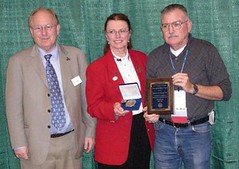 Howard was also congratulated for his winning
of the ANA's Glenn Smwedley Award for his volunteer work at the ANAs and
for other organizations, and manning a club table for NBS, NI, IBNS and
the PCF. In a photo provided by John Wilson, here's Howard receiving his
award with ANA President Barry Stuppler and VP Patricia Finner.
Howard was also congratulated for his winning
of the ANA's Glenn Smwedley Award for his volunteer work at the ANAs and
for other organizations, and manning a club table for NBS, NI, IBNS and
the PCF. In a photo provided by John Wilson, here's Howard receiving his
award with ANA President Barry Stuppler and VP Patricia Finner.The theme for our meeting was the recent ANA show. All in all it was successful for everyone. Tom Kays polled several dealers and all were quite happy. Joe said that one dealer he spoke to had his best show ever. Wayne was very pleased with the response at his coin tables and Wizard Coin Supply section. By the end of the show there was a lot of white space showing where numismatic books were stacked at the beginning.
Speaking of numismatic books, I passed around a copy of the new 100 Greatest Ancient Coins by Harlan Berk. Other books discussed included Katie Jaeger's Guide Book of U.S. Tokens and Medals, Rita Laws' book on Indian Peace Medals, and a new book by Ira Reed on The Jamestown Exposition of 1907. The book discusses the medals issued for the exposition.
A mention of John Ford prompted Joe Levine to recall running into Ford, in of all times and places, in Paris while on his honeymoon. Ford was there visiting old haunts from his service in WWII with his son in law's father. They were staying in the same hotel. Ford escorted Joe and his new bride around Paris, recounting stories of the war, his encounters with Nazis, and the black market in cigarettes. While on that same trip, the Levines ran into Paul Bosco at a coin convention in the Paris suburbs where he had a bourse table. Also, by prior arrangement, they were treated to dinner at a fine Paris restaurant by Richard Margolis and his wife.
My only book purchase was a copy of Good Money by George Selgin. Roger purchased the special leatherbound version of Len Augsburger's new book Treasure in the Cellar. Tom passed around a book he purchased at the show, the American Numismatic Manual by Montroville Dickeson.
Dave Schenkman passed around his purchase from the recent Stack's Dice-Hicks collection auction - lot 3435. It's a token of S.T. Suit of Jefferson County, Kentucky. Very rare in white metal, the 1850-dated token is Miller Ky 39. He told an interesting story about the issuer, a whiskey distiller. He fell in love with a much younger woman who refused to marry him. She relented when he promised to build her a castle - a real castle. He died before the massive home was completed.

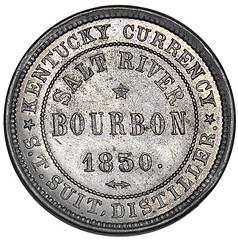
To view the complete auction description, see: Lot 3435: Kentucky. Jefferson County. S.T. Suit. 1850. Miller Ky 39. (http://www.stacks.com/lotdetail.aspx?lrid=AN00098078)
Tom Kays passed around a nice group of Spanish silver, including a cool countermarked 1773-dated quarter dollar piece. Tom writes:

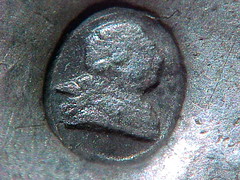
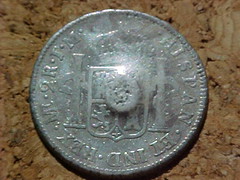
The George III punch, in use since 1784, is reminiscent of the London Goldsmiths duty mark used on jewelry and plate to denote a fee per ounce of precious metal had been paid the Inland Revenue. Goldsmiths presides over the elaborate Trial of the Pyx to certify to a jury coinage of the realm has proper gold and silver content. It makes sense that they would apply the mark. Besides dollars, this mark is scarce on Spanish half dollars and rare on smaller denominations.
By 1804 the countermarked dollars were being counterfeited, and the George III punch is said to have been used in more modern times to make fantasy pieces for collectors. Regarding this one shilling, two pence, farthing piece do any readers know how to tell the genuine from the fantasy?
Tom also notes that a number of chop marked Spanish dollars were uncovered during dredging on the Maryland side of the Potomac during the recent construction of the Wilson Bridge which carries Capitol Beltway traffic across the river. Hundreds of coins from colonial to modern date and other artifacts such as Civil War era belt buckles surfaced as the initial dredge material was dumped in Virginia and slumped or subsided after hurricane rains revealed a glittering field of glass and metal artifacts on top for one rainy day, before many more dump truck loads buried it all again quite deep. Tom had written about the hoard in the Virginia Numismatic Association Journal a couple years ago. Many thanks to Tom for providing these images of his coins.
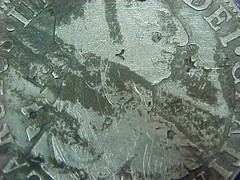
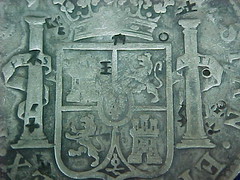
The Civil War mention reminded me of an article I'd read the other morning in The Washington Post. It seems the Civil War claimed its newest casualty just a few months ago.
Sam White, 53, was working on the nine-inch naval cannonball in the driveway of his home with a wire-brush grinder, which ignited the internal powder, exploding the shell, the Bureau of Alcohol, Tobacco, Firearms and Explosives said. No other injuries were reported in the Feb. 18 explosion.
The explosion sent a one- to two-pound section of the shell hurtling from the Chester subdivision where White lived and through the roof of a house a quarter-mile away.
White, a respected, widely known member of the Civil War relic hunting community, was using the grinder to clean residue from the shell, which dated to the 1850s or 1860s.
To read the complete article, see: Spark Ignited Powder in Civil War-Era Shell (http://www.washingtonpost.com/
wp-dyn/content/article/2008/08/11/AR2008081102365_3.html)
J. Sanford Saltus aside, at least collecting coins won't kill you. Midway through our dinner we were treated to (some might say subjected to) a rendition of "O Sole Mio" in the booming operatic voice of one of the staff. All in all, it was another memorable evening of numismatic fellowship. If any readers in the greater Washington D.C. area would like to join us sometime, let me know.
NEWSPAPER ARTICLE HIGHLIGHTS 1952 SCOVILLE SPINNER TOKEN
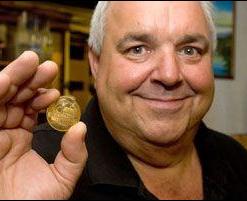 Sometimes the smallest things can trigger the
greatest memories. For father and son Robert Zabit, senior and junior,
it's a coin. But not just any coin.
Sometimes the smallest things can trigger the
greatest memories. For father and son Robert Zabit, senior and junior,
it's a coin. But not just any coin.This particular one evokes Waterbury when it was a manufacturing powerhouse, the once vibrant Brass City where, as Bob Jr. put it, "people worked hard and played hard."
Minted by the Scovill Manufacturing Co. in 1952 to commemorate its 150th anniversary, the shiny brass coin honors an industry's history on one side and a hard-drinking culture on the other.
He placed the coin, which is about the size of a 50-cent piece, face down on a counter, held it between thumb and forefinger and spun it like a top. When the spinning disk came to a stop, an arrow inscribed "YOU PAY" pointed in his direction.
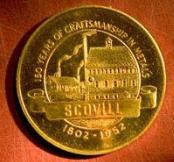
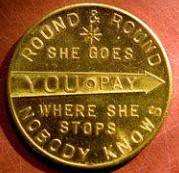
"I guess I buy the round," he laughed.
This is a bar coin, an emblem of a bygone era when factory workers filed into their favorite joint at the end of their shift and, if lucky, could have three or four beers without paying for any of them.
"But you had to stand at the corner of the bar when you spun it, so everyone had a chance of getting stuck with the bill," Zabit explained.
"I remember that," recalled Waterbury's Joseph Begnal, who owned Joe Begnal's Brown Derby right across from the entrance to Scovill's main plant on East Main Street. "We always kept one in the drawer."
Bob senior, a tool setter in Scovill's cosmetic division, was one of "the last three to walk out the door" before the factory closed for good. He still lives nearby. The coin and a key chain inscribed with the exact date the plant closed Nov. 3, 1989 are mementos from 40 years of work he has turned over to his son.
"We share Waterbury's manufacturing history," said Bob junior, 55, who worked for Eastern Color Printing before buying Larry's Wines & Spirits in Middlebury 15 years ago.
The coin is not only rare, but handsomely designed; tactile proof of the company inscription that reads "150 years of craftsmanship in metals." Barely visible within a embossed scene of Scovill's original 1802 plant is a slightly protruding axis point so precisely centered that the coin spins without quavering for nearly a full minute with an easy flick of the fingertips. On the reverse side, along with that fateful arrow, is written: ROUND & AND ROUND SHE GOES, WHERE SHE STOPS NOBODY KNOWS
"By the time that thing stopped, there were a half-dozen pints already on the bar," said Zabit.
To read the complete article, see: Coin in Waterbury evokes memories of Scovill (http://www.rep-am.com/News/359390.txt)
FIRM TOUTS SOFTWARE USED BY U.S. MINT TO DESIGN COINS
United States Mint coins created using FreeForm that are available for viewing in booth 154 at the Los Angeles Convention Center include:
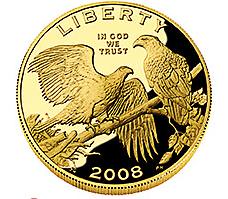
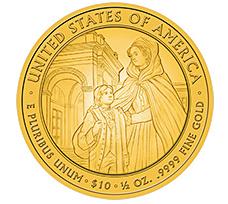
- Bald Eagle Half-Dollar, 2008, obverse (front side) part of the American Eagle Commemorative Coin series, this clad coin features a highly crafted baby eagle in the foreground, against a background of a striped US flag.
- James Monroe $1 Coin, 2008, obverse (front side) one of four Presidential coins being issued this year. SensAbles FreeForm was used to create the obverses likeness of the President, complete with prominent cheekbones and chin.
- Louisa Adams $10 Gold Coin, 2008, reverse (tail side) part of The First Spouse Gold Coin series, featuring an image of Louisa and son Charles in front of graceful Arc de Triomphe-style arches that symbolize their journey across Europe to join her husband John Quincy Adams in Paris during his diplomatic years.
- Arizona State Quarter, 2008, reverse (tail side) a currently circulating coin featuring an image of the Grand Canyon at the top, a Saguaro cactus in the foreground, and a banner across the middle reading "Grand Canyon State." Because the Saguaro cactus does not grow in the Grand Canyon, the high-relief banner visually separates the other images.
The FreeForm system is used by engravers and collectible product designers in many fields because it is tailored for creating curved, organic and non-geometric shapes. Instead of using a computer mouse, FreeForm users hold a stylus-like PHANTOM haptic device, and literally sculpt by touch actually feeling the coins surface as they are designing on-screen just as they would if they were working with wax or clay.
To read the complete article, see: SensAbles FreeForm 3D Modeling System Used To Design New Coins (http://www.businesswire.com/portal/site/google/?
ndmViewId=news_view&newsId=20080812005286)
CARSON CITY CELEBRATES 150TH WITH MEDALS AND CUPCAKES
Robert Nylen, Curator of History at Nevada State Museum, kicked off a day-long celebration with a presentation on the history of the Mint. Half hour later they begsn striking 150th Anniversary medals on equipment right there in the Mint. An hour later attendees heard the Museum's McAvoy Layne tell about the city's close relationship with Mark Twain in "The Coins and Curiosities of the Comstock - Chautauqua." Let's hope both these talks get published.
Then from 1 to 3 pm Will Robins talked about "Coins in Nevada History" and conducted a Morgan Dollar Grading Seminar. Another talk that should be published for the millions of us interested in Carson City Mint and its coins. At 3 pm they held a drawing for men's and a women's Coin Watches.
Carson City did everything right. They started early, two years ago. They hired a professional public relations firm. They involved every level of the city organizations. They gave emphasis to the Historical Society. They got donations, sponsors and volunteers. Their celebrations involved every level of society and included activities for children. They had a medal struck.
Carson City should get a medal for its well planned celebration.
To read the complete article, see: Getting ready for 150th no simple task (http://www.nevadaappeal.com/article/20080814/NEWS/857019418/1060/)
PLAN TO MELT PRE-1982 U.S. CENTS FAILS TO SOLIDIFY
Dick Johnson forwarded this story. He writes:What happened to an Ohio company's plans to melt old pennies and extract their copper?
The company that wanted a legislative change that would let it melt the coins isn't banking on getting its way anytime soon.
Jackson Metals, which is south of Columbus in Jackson County, had hoped to melt down pennies minted before 1982, whose components are now worth 1.7 cents per coin, and sell the copper to makers of brass products such as doorknobs and plumbing fixtures. The company's plans are blocked by a U.S. Mint ban on melting pennies, a rule designed to prevent coin shortages.
To read the complete article, see: Plan to melt pennies fails to solidify (http://www.cleveland.com/news/plaindealer/index.ssf?
/base/cuyahoga/1218443453136590.xml&coll=2)
COUNTERFEITS ON THE INTERNET: TIFFANY VS EBAY
Tiffany & Company and eBay are battling it out in court over the sales of counterfeit merchandise. eBay's position is that it is okay to allow the sales of counterfeit Tiffany items in its internet marketplace. Tiffany, obviously, wants eBay to halt such sales. So far eBay has won. Tiffany is appealing. At risk are Tiffany silver items, perhaps even Tiffany medals.In 2004 when Tiffany & Co first filed its suit "it notified the auction site that 73 percent of a random sample of supposed Tiffany listings were, in fact, counterfeit." It asked that eBay examine the listings of any seller offering five or more Tiffany items. eBay insists it is not their job to protect Tiffany's trademarks.
An excellent article appeared this week on the Tiffany vs. eBay suit.
To read the complete article, see: Tiffany appeals ruling in eBay counterfeit listings case (http://news.cnet.com/8301-13578_3-10013681-
38.html?part=rss&subj=news&tag=2547-1_3-0-5)
NEW TOOL TO PIGGYBACK ON MILLIONS OF WEB USERS TO DIGITIZE BOOKS
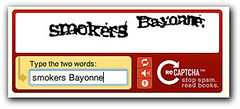 The system of squiggly characters that must be
typed correctly to gain access to certain Web sites has annoyed online
users for years. Now, the primary inventor of the security technique wants
to make amends -- by making Web users decipher even more squiggly
words.
The system of squiggly characters that must be
typed correctly to gain access to certain Web sites has annoyed online
users for years. Now, the primary inventor of the security technique wants
to make amends -- by making Web users decipher even more squiggly
words.Luis von Ahn devised the system of distorted images of letters and numbers in 2000 as a way for email providers, online ticket sellers and other Web services to weed out online undesirables such as computerized ticket scalpers and spammers. The droopy characters, called Captchas, are irritating to humans, but are usually indecipherable to computers, providing a security screen for online service providers.
After widespread adoption of the Captcha system, Mr. von Ahn, a 29-year-old assistant professor at Carnegie Mellon University here, is putting his technique to work in another security scheme, dubbed ReCaptcha. This time, he wants users to assist with what he thinks is an important public service: helping get old books and newspapers online as part of digitized libraries.
The ReCaptcha system presents each user with two words containing distorted characters. Both words come from an old book or newspaper article that has been scanned into an online library. One word has been recognized by the scanning computer, but the other -- possibly because of a smudge or other imperfection on the original document -- can't be made out by the computer's software.
The user tries to decipher the distorted characters and types in both words. If the user matches the computer with the already understood word, then the user's reading of the mystery word is registered.
Other Web users will be shown the same unknown word. When three people have typed in the troublesome characters the same way, the mystery word is considered solved and the system transmits it to the library database so the word can be inserted into the document's digitized version.
When the ReCaptcha project is fully up and running, this month or in early September, Mr. von Ahn expects it to process about 160 books a day being scanned by the Internet Archive, a San Francisco nonprofit. The Internet Archive has paid employees scanning 1,000 books a day at 70 public and university libraries, mostly in the U.S., from the Library of Congress to the Allen County Public Library, in Fort Wayne, Ind.
Computers that run ReCaptcha automatically retrieve scanned books from the Internet Archive's servers, process them, and return the results, devoting an average of nine minutes of working time per book.
Most of the books can be digitized using typical optical character recognition software. Those that prove troublesome are to be handled by ReCaptcha.
"It's a really mind-blowing application," says Internet Archive founder Brewster Kahle.
To read the complete article, see: Web-Security Inventor Charts a Squigglier Course (http://online.wsj.com/article/SB121857740590934637.html)
PAY BILLS WITH YOUR CELL PHONE USING OBOLS
Consumer habits are changing. The number of bank ATMs fell 9 percent last year. The number of cash transactions dropped an identical 9 percent. However, use of credit and debit cards and online banking is rising. If Carol Realini has her way, consumers will be paying by cell phone. Realini is founder and CEO of a Silicon Valley start-up called Obopay.
"People start to use it and they say, 'Oh this changes the way I do things. This changes the way I settle up bills with my friends. It changes the way my mother sends me money. It's the way I pay my bills back to my family members.' So it changes the way things are," says Realini. Obopay uses your cell phone as a payment device by transferring money from one cell phone user to another. It draws funds from a debit account you set up with Obopay. Payments can be done simply by texting or by using software installed on the phone. The sender is charged a small fee. It is ideal for paying merchants who typically operate on a cash basis.
The concept is high-tech, but CEO Carol Realini admits the idea originated in 2000 during a visit to a mobile phone store in Africa.
"People were standing in line with bags of money to buy their prepaid minutes. They'd take the prepaid minutes and they'd put them in their cell phones, and then they'd start making phone calls, and it just occurred to me that this system could be changed and altered and it would give everyone with a cell phone access to banking services," says Realini.
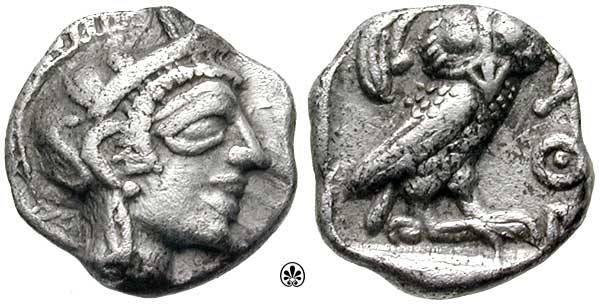
The name Obopay is derived from the name of an ancient Greek coin, the obol. For now, Obopay is available in the U.S. and in India, but it is very clear that the service eventually could go global.
To read the complete article, see: Pay bills with your cell phone (http://abclocal.go.com/kgo/story?section=news/assignment_7&id=6323447)
For more information about Obolpay, see: www.obopay.com/
TREASURE HUNT: A TWIST ON THE OLD COIN DROP PUBLICITY PLOY
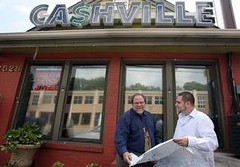 Somewhere in Nashville, a "gold" coin worth $500
awaits discovery, hidden in a very public place that's somehow relevant to
the city's history.
Somewhere in Nashville, a "gold" coin worth $500
awaits discovery, hidden in a very public place that's somehow relevant to
the city's history.The person who finds it has a choice to make: keep this coin or trade it in for the $500.
If this scenario sounds like something out of a pirates-and-buried-treasure-hunt movie or book, it's because it is exactly that.
Cashville Gold & Silver Buyers, 2528 Franklin Road in Berry Hill, has launched a citywide treasure hunt. The reason, according to Josh Levine, Cashville's president, and Julie Schoerke, owner of the JKS Communications public relations firm, is mostly the economy.
"Lots of contests have started in giving away $50 gas cards, but we thought it was much more fun to have a $500 real gold coin to give away," Schoerke said.
For the treasure hunt, Levine decided to use a half-ounce gold U.S.A. Eagle coin, but that's not what people will find if they discover the location of the treasure.
"We're using a replica," Levine said. "It will be an obviously fake coin. We want people to purposely find it and bring it back here instead of accidentally finding and keeping a $500 gold coin out there."
If the first hunt is a success, Levine and Schoerke plan to do subsequent hunts and keep doing them as long as they're popular, they said.
To read the complete article, see: Business owners see treasure hunt as way to soften economic woes (http://www.tennessean.com/apps/pbcs.dll/article?
AID=/20080811/NEWS01/808110365/1006)
A "HOBO" HOMER SIMPSON ON A SPANISH EURO COIN
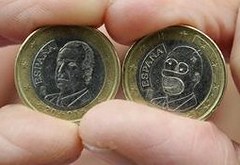 A one euro coin has turned up in Spain bearing
the face of cartoon couch potato Homer Simpson instead of that of the
country's king, a sweetshop owner told Reuters on Friday.
A one euro coin has turned up in Spain bearing
the face of cartoon couch potato Homer Simpson instead of that of the
country's king, a sweetshop owner told Reuters on Friday.Jose Martinez was counting the cash in his till in the city of Aviles, northern Spain, when he came across the coin where Homer's bald head, big eyes and big nose had replaced the serious features of King Juan Carlos.
"The coin must have been done by a professional, the work is impressive," he told Reuters.
"I've been offered 20 euros for it," said Martinez.
To read the complete article, see: Spanish shopkeeper finds Homer Simpson euro (http://uk.reuters.com/article/oddlyEnoughNews/
idUKL872708020080808)
FEATURED WEB PAGE: ANCIENT MONSTERS ON ANCIENT COINS
This week's featured web page is Bill Welch's Ancient Monsters on Ancient Coins.From the web site:

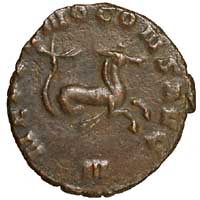
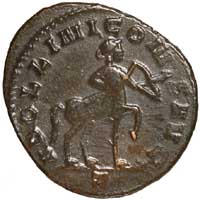
http://www.forumancientcoins.com/moonmoth/
monster_coins.html

